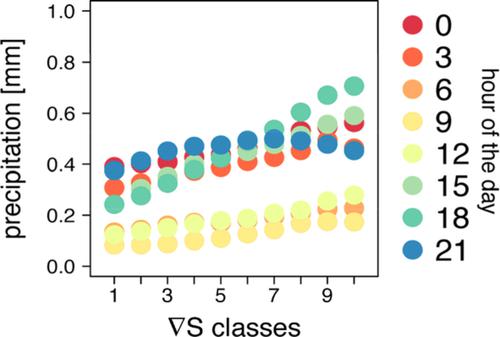当前位置:
X-MOL 学术
›
Hydrol. Process.
›
论文详情
Our official English website, www.x-mol.net, welcomes your
feedback! (Note: you will need to create a separate account there.)
Is the soil moisture precipitation feedback enhanced by heterogeneity and dry soils? A comparative study
Hydrological Processes ( IF 2.8 ) Pub Date : 2021-08-03 , DOI: 10.1002/hyp.14332 Maximilian Graf 1, 2 , Joël Arnault 1 , Benjamin Fersch 1 , Harald Kunstmann 1, 2
Hydrological Processes ( IF 2.8 ) Pub Date : 2021-08-03 , DOI: 10.1002/hyp.14332 Maximilian Graf 1, 2 , Joël Arnault 1 , Benjamin Fersch 1 , Harald Kunstmann 1, 2
Affiliation

|
The interaction between the land surface and the atmosphere is a crucial driver of atmospheric processes. Soil moisture and precipitation are key components in this feedback. Both variables are intertwined in a cycle, that is, the soil moisture – precipitation feedback for which involved processes and interactions are still discussed. In this study the soil moisture – precipitation feedback is compared for the sempiternal humid Ammer catchment in Southern Germany and for the semiarid to subhumid Sissili catchment in West Africa during the warm season, using precipitation datasets from the Climate Hazards Group InfraRed Precipitation with Station data (CHIRPS), from the German Weather Service (REGNIE) and simulation datasets from the Weather Research and Forecasting (WRF) model and the hydrologically enhanced WRF-Hydro model. WRF and WRF-Hydro differ by their representation of terrestrial water flow. With this setup we want to investigate the strength, sign and variables involved in the soil moisture – precipitation feedback for these two regions. The normalized model spread between the two simulation results shows linkages between precipitation variability and diagnostic variables surface fluxes, moisture flux convergence above the surface and convective available potential energy in both study regions. The soil moisture – precipitation feedback is evaluated with a classification of soil moisture spatial heterogeneity based on the strength of the soil moisture gradients. This allows us to assess the impact of soil moisture anomalies on surface fluxes, moisture flux convergence, convective available potential energy and precipitation. In both regions the amount of precipitation generally increases with soil moisture spatial heterogeneity. For the Ammer region the soil moisture – precipitation feedback has a weak negative sign with more rain near drier patches while it has a positive signal for the Sissili region with more rain over wetter patches. At least for the observed moderate soil moisture values and the spatial scale of the Ammer region, the spatial variability of soil moisture is more important for surface-atmosphere interactions than the actual soil moisture content. Overall, we found that soil moisture heterogeneity can greatly affect the soil moisture – precipitation feedback.
中文翻译:

异质性和干燥土壤是否增强了土壤水分降水反馈?比较研究
地表和大气之间的相互作用是大气过程的关键驱动因素。土壤水分和降水是这种反馈的关键组成部分。这两个变量在一个循环中交织在一起,即土壤水分 - 降水反馈,其所涉及的过程和相互作用仍在讨论中。在这项研究中,使用来自气候危害组红外降水和站点数据的降水数据集,比较了德国南部半永久潮湿的阿默流域和西非半干旱至半湿润西西里流域在温暖季节的土壤水分 - 降水反馈( CHIRPS),来自德国气象局 (REGNIE) 以及来自天气研究和预报 (WRF) 模型和水文增强型 WRF-Hydro 模型的模拟数据集。WRF 和 WRF-Hydro 的不同之处在于它们对陆地水流的表示。通过此设置,我们希望研究这两个区域的土壤水分 - 降水反馈中涉及的强度、符号和变量。两个模拟结果之间的归一化模型分布显示了降水变率与诊断变量地表通量、地表上方的水分通量收敛和两个研究区域的可用对流势能之间的联系。土壤水分 - 降水反馈通过基于土壤水分梯度强度的土壤水分空间异质性分类进行评估。这使我们能够评估土壤水分异常对地表通量、水分通量收敛、对流可用势能和降水的影响。在这两个地区,降水量通常随着土壤水分空间异质性而增加。对于 Ammer 地区,土壤水分 - 降水反馈具有弱的负信号,在较干燥的斑块附近降雨较多,而对于 Sissili 地区则具有正信号,较湿的斑块上有更多的降雨。至少对于观测到的中等土壤水分值和 Ammer 地区的空间尺度而言,土壤水分的空间变异性对于地表-大气相互作用比实际土壤水分含量更为重要。总体而言,我们发现土壤水分异质性可以极大地影响土壤水分-降水反馈。对于 Ammer 地区,土壤水分 - 降水反馈具有弱的负信号,在较干燥的斑块附近降雨较多,而对于 Sissili 地区则具有正信号,较湿的斑块上有更多的降雨。至少对于观测到的中等土壤水分值和 Ammer 地区的空间尺度而言,土壤水分的空间变异性对于地表-大气相互作用比实际土壤水分含量更为重要。总体而言,我们发现土壤水分异质性可以极大地影响土壤水分-降水反馈。对于 Ammer 地区,土壤水分 - 降水反馈具有弱的负信号,在较干燥的斑块附近降雨较多,而对于 Sissili 地区则具有正信号,较湿的斑块上有更多的降雨。至少对于观测到的中等土壤水分值和 Ammer 地区的空间尺度而言,土壤水分的空间变异性对于地表-大气相互作用比实际土壤水分含量更为重要。总体而言,我们发现土壤水分异质性可以极大地影响土壤水分-降水反馈。对于地表-大气相互作用而言,土壤水分的空间变异性比实际土壤水分含量更为重要。总体而言,我们发现土壤水分异质性可以极大地影响土壤水分-降水反馈。对于地表-大气相互作用而言,土壤水分的空间变异性比实际土壤水分含量更为重要。总体而言,我们发现土壤水分异质性可以极大地影响土壤水分-降水反馈。
更新日期:2021-09-10
中文翻译:

异质性和干燥土壤是否增强了土壤水分降水反馈?比较研究
地表和大气之间的相互作用是大气过程的关键驱动因素。土壤水分和降水是这种反馈的关键组成部分。这两个变量在一个循环中交织在一起,即土壤水分 - 降水反馈,其所涉及的过程和相互作用仍在讨论中。在这项研究中,使用来自气候危害组红外降水和站点数据的降水数据集,比较了德国南部半永久潮湿的阿默流域和西非半干旱至半湿润西西里流域在温暖季节的土壤水分 - 降水反馈( CHIRPS),来自德国气象局 (REGNIE) 以及来自天气研究和预报 (WRF) 模型和水文增强型 WRF-Hydro 模型的模拟数据集。WRF 和 WRF-Hydro 的不同之处在于它们对陆地水流的表示。通过此设置,我们希望研究这两个区域的土壤水分 - 降水反馈中涉及的强度、符号和变量。两个模拟结果之间的归一化模型分布显示了降水变率与诊断变量地表通量、地表上方的水分通量收敛和两个研究区域的可用对流势能之间的联系。土壤水分 - 降水反馈通过基于土壤水分梯度强度的土壤水分空间异质性分类进行评估。这使我们能够评估土壤水分异常对地表通量、水分通量收敛、对流可用势能和降水的影响。在这两个地区,降水量通常随着土壤水分空间异质性而增加。对于 Ammer 地区,土壤水分 - 降水反馈具有弱的负信号,在较干燥的斑块附近降雨较多,而对于 Sissili 地区则具有正信号,较湿的斑块上有更多的降雨。至少对于观测到的中等土壤水分值和 Ammer 地区的空间尺度而言,土壤水分的空间变异性对于地表-大气相互作用比实际土壤水分含量更为重要。总体而言,我们发现土壤水分异质性可以极大地影响土壤水分-降水反馈。对于 Ammer 地区,土壤水分 - 降水反馈具有弱的负信号,在较干燥的斑块附近降雨较多,而对于 Sissili 地区则具有正信号,较湿的斑块上有更多的降雨。至少对于观测到的中等土壤水分值和 Ammer 地区的空间尺度而言,土壤水分的空间变异性对于地表-大气相互作用比实际土壤水分含量更为重要。总体而言,我们发现土壤水分异质性可以极大地影响土壤水分-降水反馈。对于 Ammer 地区,土壤水分 - 降水反馈具有弱的负信号,在较干燥的斑块附近降雨较多,而对于 Sissili 地区则具有正信号,较湿的斑块上有更多的降雨。至少对于观测到的中等土壤水分值和 Ammer 地区的空间尺度而言,土壤水分的空间变异性对于地表-大气相互作用比实际土壤水分含量更为重要。总体而言,我们发现土壤水分异质性可以极大地影响土壤水分-降水反馈。对于地表-大气相互作用而言,土壤水分的空间变异性比实际土壤水分含量更为重要。总体而言,我们发现土壤水分异质性可以极大地影响土壤水分-降水反馈。对于地表-大气相互作用而言,土壤水分的空间变异性比实际土壤水分含量更为重要。总体而言,我们发现土壤水分异质性可以极大地影响土壤水分-降水反馈。











































 京公网安备 11010802027423号
京公网安备 11010802027423号